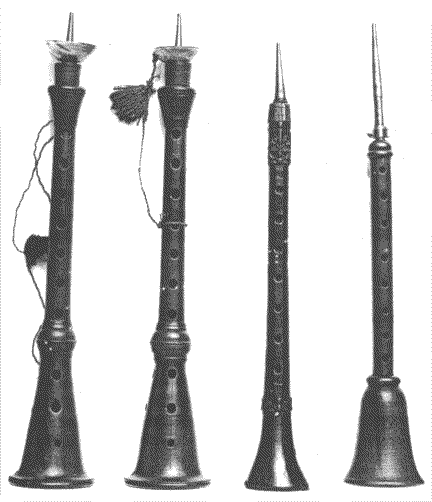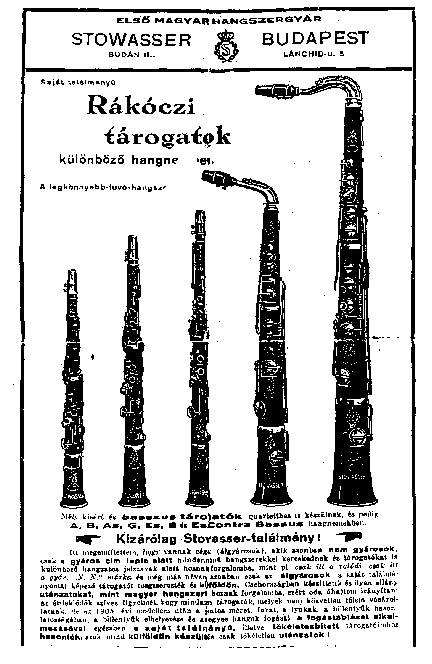Stephen
Fox
|
Stephen Fox
The tárogató (Hungarian, plural tárogatók), alias taragot or torogoata (Romanian), used traditionally in Eastern European folk music, has recently begun to reach a wider Western audience due to increasing interest in world music and its use in klezmer music. The tárogató of the present day bears very little resemblance to the instrument bearing the same name in earlier times. Before the mid 19th century, the term referred to keyless, conical bored, double reed instruments - shawms, generically speaking - which took a number of forms: straight or curved body, simple or with beadlike knobs; with an integral wooden bell or a metal bell. Mention of the tárogató in Hungarian writings dates back at least as long ago as the 15th century. It is not clear whether it was first brought into Europe by the Magyars when they first immigrated from the east in the 9th century. It is certain, however, that instruments of this type, decended from the Middle Eastern zurna, were introduced into Eastern Europe by the Turks in the Middle Ages, as evidenced by the term töröksip - "Turkish pipe" - which was used as a synonym for tárogató. It is possible that instruments from both traditions were combined into one entity. Similarly to the Scots bagpipe, the early tárogató was used principally as a signalling device on the battlefield, and secondarily as an instrument for outdoor music, at ceremonies such as weddings and funerals. It became a symbol of Hungarian nationalism during the kuruc uprising of 1703-11 led by Prince Ferenc Rákóczi, to the point that its use was banned by the Austrian authorities.
Keyless double reed tárogatók,
early 17th to early 19th century,
Following the attempted Hungarian war of independence of 1848-49, which was suppressed but which launched an irrevocable movement towards nationhood, the tárogató was revived as a national symbol. A number of attempts were made to create a modern instrument with the tárogató as a basis - András Szuk's version of 1859, based on an early English horn design, and the 13 key instrument of Albert Skripsky from 1860, are examples - but they were not successful in gaining popularity. With the approach of the Hungarian millenium celebrations in 1895, the Budapest instrument maker Venzel József Schunda (1845-1923) tried his hand at designing "national" musical instruments. To this end he produced the concert cimbalom - a complex, powerful, piano-sized instrument which is far removed from the simple little hammered dulcimer from which it is derived - and a modern tárogató. Several years of experimentation, beginning with double reed instruments, led in 1894-96 to the single reed instrument that we know today. In this enterprise he worked in conjunction with the performer Gyula Káldy, who authored the first method book for the new instrument. The new tárogató could be roughly described as a soprano saxophone - in the Schunda design the bore proportions and taper angle are in fact exactly the same as in contemporary soprano saxophones - with the body made of wood, and with keywork modelled on that of simple German clarinets (the fingering pattern is similar in principle to what is known as the "Albert system" in North America and the "simple system" in the U.K.) The mechanism featured a single octave key, a ring key on the lower joint but none on the upper, and a range down to low Bb, the key for which was operated by the right thumb. The mouthpiece was smaller than a soprano saxophone's, and was intended to use (German) clarinet reeds.
A number of other Hungarian woodwind makers followed Schunda's lead in producing tárogatók, with some variations in mechanism and materials. The most highly reputed maker was János Stowasser (1865-19??), whose instruments are still prized today. Stowasser tárogatók have somewhat more complex keywork than Schunda's - they all have two octave keys (usually operated by separate thumb touchpieces, though occasionally fully automatic as on the saxophone) and a ring key on the upper joint - and they have a slightly steeper bore taper angle, with a smaller diameter at the top end.
(As a cautionary note when assessing tárogatók for purchase, instruments made by Stowasser are lavishly inscribed with elaborate trademark crests and patent numbers. Instruments with the word "Stowasser" simply stamped in block letters are unlikely to be genuine.) The
soprano tárogató in Bb is and has always been by far the
most common type; however, Stowasser advertised as many as seven sizes,
down to a contrabass in Eb. Some examples of these are preserved
in the collection of the Magyar Nemzeti Muzeum in Budapest.
Following the Second World War,state disapproval of overt expressions of nationalism, combined with the severing of contact with the German tradition of woodwind instrument making, led to a halt in the manufacture of tárogatók in Hungary. The instrument continued to be made in some other Eastern European countries, most notably Romania, though the quality of these examples has usually been extremely poor. Beginning in the 1990s, a couple of makers in Hungary have begun production of tárogatók of reasonable quality. Current makers of tárogatók outside Eastern Europe include Karl Hammerschmidt & Söhne in Germany, and the present writer. Most 20th century tárogatók are made from native European wood: most often fruitwoods, sometimes boxwood. In some examples the wood is left naturally coloured, though often it is stained black and lacquered, sometimes obliterating the identity of the wood (in some cases to such an extent that it no longer appears to be wood; the Schunda tárogató in the Boosey & Hawkes museum in London, for instance, is catalogued as being made from "ebonite", though it is in fact varnished wood). Some of the more advanced Stowasser instruments are made from rosewood. Besides availability and working properties, weight is a factor when choosing the type of wood to use when making a tárogató. On most tárogatók, the mouthpiece tenon is located on the upper joint, with the mouthpiece fitting over it (as on the saxophone), though on the Schunda and certain others the tenon is on the mouthpiece (as with the clarinet). The original narrow mouthpiece has often in recent decades been replaced by a wider type, using a soprano saxophone reed, in the interests of increased volume but possibly to the detriment of tone control. Obtaining good mouthpieces has been a major obstacle in making instruments function satisfactorily, though excellent reproductions of original Stowasser mouthpieces are now available. It is also possible to make a usable tárogató mouthpiece from a soprano saxophone mouthpiece, by installing a bore insert and making whatever modifications are necessary to fit the mouthpiece to the upper joint. While Schunda's concert cimbalom is well known to the public and has found a partial home in the symphony orchestra, at least in compositions of an avowedly Hungarian nature - Kodály's opera Háry János and the instrumental suite extracted from it, and the orchestral transcriptions of Liszt's Hungarian Rhapsodies Nos. 1 and 3, are familiar examples - the tárogató was not so favoured, and in fact has generally been given a cold shoulder by the "serious" musical establishment. It has been used (in Budapest, at Covent Garden in London and occasionally at Bayreuth) for the shepherd's solo in Wagner's Tristan und Isolde (though it is not correct that the instrument was originally built for that purpose, as has been mistakenly written). The concert piece Kuruc muzsika (1936) for four tárogatók and chamber orchestra by the Hungarian composer Antal Molnár, and the Concerto for tárogató and chamber orchestra (1977) by the Austrian composer Armin Kaufman, are other examples of its very infrequent appearance in the concert hall. The Hungarian player Csaba Nagy has attempted to carve out a niche for the tárogató in "legitimate" music, albeit largely through performance of works originally written for other instruments. In the past ten years or so, publishers in Hungary have begun to reprint some tárogató music from the turn of the 20th century, including Gyula Káldy's 1901 method, Elméleti es gyakorlati tárogató iskola (Edition Neuma). It is in folk music in Hungary, Transylvania and other parts of Romania that the modern tárogató was adopted most readily, though in recent years its position has begun to be usurped by the louder and more readily accessible saxophone, especially in Romania. One well known performer in this genre is Dumitru Farcas (one good recorded example of his work is heard on the Arion album Romanian Flutes, reissued on CD but regrettably now out of print). Players of folk/klezmer/"world fusion" music in Western countries have adopted the tárogató to a certain degree, though it still takes a back seat to the clarinet and the saxophone. It
is hoped that the unique sound and heritage of the tárogató
will ensure for it a lasting place in the woodwind spectrum.
Copyright 2004 by Stephen Fox |
|||||||||



